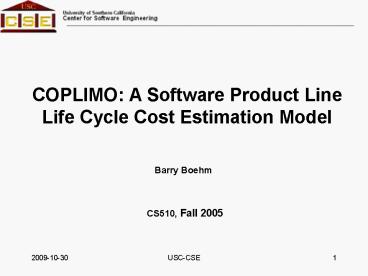Barry Boehm - PowerPoint PPT Presentation
1 / 20
Title:
Barry Boehm
Description:
And two other contributing variables. Required Reliability (RELY) ... Note: RCWR not applied to non-reused portion, where many other models overestimate RCWR ... – PowerPoint PPT presentation
Number of Views:97
Avg rating:3.0/5.0
Title: Barry Boehm
1
COPLIMO A Software Product Line Life Cycle Cost
Estimation Model
Barry Boehm
CS510, Fall 2005
2
Outline
- Background
- Constructive Product Line Investment Model
(COPLIMO) - The product line development cost model
- The annualized post-development life cycle
extension - Conclusions
3
Background
- Benefits vs. Costs of product line
- Does product line pay?
- Traditional product line cost estimation models
mostly underestimate the ROI for product lines by
focusing only on development savings - Apply RCWR surcharge to entire product not only
to the reused portions - If life cycle costs are considered, high payoff
comes from a smaller code base to undergo
maintenance - COPLIMO life cycle model addresses the
shortfalls, and helps to - Determine whether it pays to develop software
product as a product line - Estimate how many members of the product line
family will be developed - Compare ROIs from different scoping of a product
line
4
Outline
- Background
- Constructive Product Line Investment Model
(COPLIMO) - The product line development cost model
- The annualized post-development maintenance cost
model - Conclusions
5
COPLIMO Model Overview
- Based on COCOMO II software cost model
- Statistically calibrated to 161 projects,
representing 18 diverse organizations - Based on standard software reuse economic terms
- RCWR Relative Cost of Writing for Reuse
- RCR Relative Cost of Reuse
- Avoids investment overestimation, savings
underestimation - Avoids RCWR for non-reused components
- Includes savings from smaller life-cycle code
base - Provides experience-based default parameter
values - Simple Excel spreadsheet model
- Easy to modify, extend, interoperate
6
COPLIMO - RCWR
- Development for Reuse (RUSE)
- In COCOMO II Database, 11 out of 161 projects
rated as VH for RUSE, and 1 rated as XH - Productivity range of 1.24/0.95 1.31
- And two other contributing variables
- Required Reliability (RELY)
- At least Nominal for Nominal and High RUSE
ratings, - At least High for Very High and Extra High RUSE
ratings - Degree of Documentation (DOCU)
7
COPLIMO RCWR (Cont.)
- Required Reliability (RELY)
- Constraints At least Nominal for Nominal and
High RUSE ratings, at least High for Very High
and Extra High RUSE ratings - Degree of Documentation (DOCU)
- Constraint No more than one level below the RUSE
rating
8
COPLIMO RCR
- Reused, or Black Box (unmodified code) RCR model
- Assessment and
- Assimilation (AA) factor
- Adapted, or White Box (modified code) RCR model
- AA
- Non-Linear Model
9
Guidelines for Quantifying Adapted Software
10
Outline
- Background
- Constructive Product Line Investment Model
(COPLIMO) - The Basic product line development cost model
- The annualized post-development life cycle
extension - Conclusions
11
Basic COPLIMO Development Cost Model (1)
- Simplifying assumptions about uniformity and
stability - Every product roughly the same size (PSIZE)
- Roughly the same fractions of product-specific
(PFRAC), adapted (AFRAC), and reused (RFRAC)
software - Inputs and outputs
12
Basic COPLIMO Development Cost Model (2)
- RCWR
- RCWR RUSE DOCU RELY
- 1 product development effort
- Non-PL Effort for developing N similar products
- PMNR (N) N ? A? (PSIZE)B ? ? (EM)
- Where PSIZE is the general software product size,
A and B are the COCOMO II calibration coefficient
and scale factor, and ? (EM) is the product of
the effort multipliers for the COCOMO II cost
drivers - PL Effort (the first product)
- PMR (1) PMNR (1) PFRAC RCWR(AFRACRFRAC)
- Note RCWR not applied to non-reused portion,
where many other models overestimate RCWR
- RCR parameters
13
Basic COPLIMO Development Cost Model (3)
- Determining RCR
- Equiv. size of product- specific portion
- Equiv. size of reused portion
- Equiv. size of adapted portion
- Total EKSLOC
- Effort
- ROI (PL Effort Savings for K products - PL
Reuse Investment) / PL Reuse Investment
PMR (N) N ? A? (EKSIZE)B ? ? (EM)
14
(No Transcript)
15
Outline
- Background
- Constructive Product Line Investment Model
(COPLIMO) - The product line development cost model
- The annualized post-development life cycle
extension - Conclusions
16
Basic COPLIMO Annualized Life Cycle Cost Model
- Annual Change Traffic (ACT)
- relative fraction of a products software that is
modified per year
17
Basic COPLIMO Annualized Life Cycle Cost Model
(1)
- Annual Change Traffic (ACT)
- Relative fraction of a products software that is
modified per year - Life cycle effort without reuse
- Annual maintained software
- L times maintenance effort
- Life cycle effort with reuse
- Three categories of annual maintenance and AMSIZE
18
(No Transcript)
19
(No Transcript)
20
Conclusions
- Software product line payoffs are significant
- Especially across life cycle
- Less code to maintain
- Cost models and business case analysis enable
assessment of situation-dependencies - Lead to better product line decisions
- COPLIMO avoids investment overestimation, savings
underestimation - Further extensions feasible































